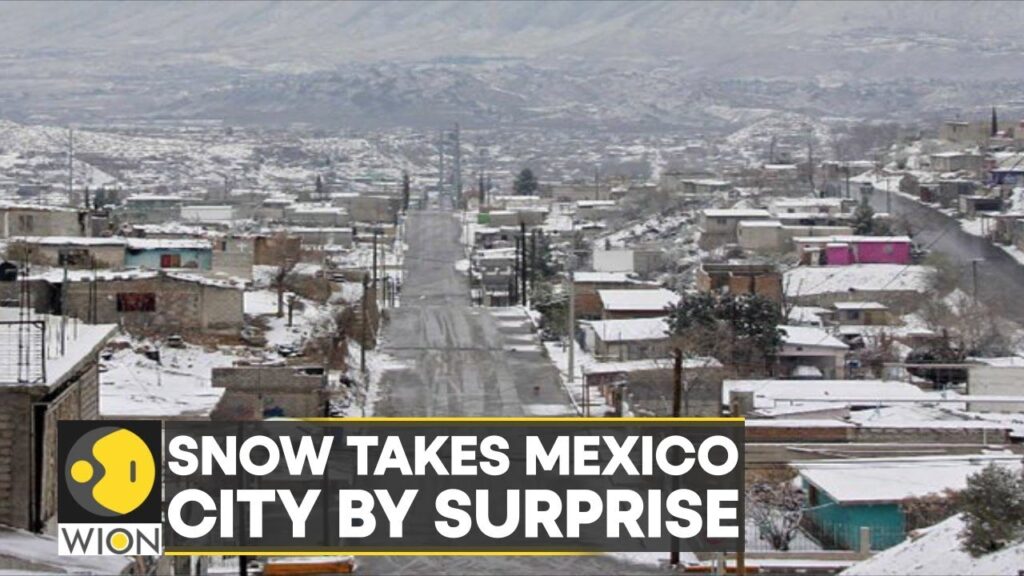Exploring the Climate: Does Mexico City Get Snow?
One might wonder about the weather patterns of a vibrant city like Mexico City, especially when it comes to the phenomenon of snow. This sprawling metropolis, nestled in the Valley of Mexico and surrounded by mighty mountain ranges, experiences a subtropical highland climate. Due to this unique climatic condition, the temperatures are generally mild, with a considerable range between day and night. However, the question of snow within the city limits sparks curiosity among many travelers.
Historically speaking, snow in Mexico City is an exceptionally rare event. The city’s last significant snowfall occurred over half a century ago, in the early 1960s. Since then, the residents and visitors of Mexico City have only witnessed light snow flurries that don’t stick to the ground or transform the landscape into a wintry wonderland. It’s crucial to understand that while the city itself might not receive snow, the surrounding mountainous areas are privy to snowfall during the winter months, offering a chilly escape for those seeking snow-covered scenes.
Elevation plays a critical role in this climatic phenomenon. Situated at an altitude of 2,250 meters (7,382 feet) above sea level, Mexico City’s climate is cooler than other regions located at a similar latitude. Despite this elevation, the city’s winter temperatures typically hover around a minimum of 5°C (41°F) and can reach up to 21°C (70°F) during the day. These conditions are far from the freezing temperatures necessary for snow to occur, contributing to the city’s snowless reputation.
For adventurers keen on experiencing snow in the proximity of Mexico City, there are options. Several peaks within a few hours’ drive from the city, such as the Nevado de Toluca, Iztaccíhuatl, and Pico de Orizaba, offer snowy landscapes during the right months. While Mexico City itself may not showcase a snowy landscape, these destinations provide a wintry adventure for those willing to travel a bit further from the city’s hustle and bustle.
The Rarity of Snow in Mexico City: A Surprising Phenomenon
Snow in Mexico City is indeed a rare spectacle that captivates both locals and tourists alike. While many parts of the world annually brace themselves for snowy seasons, the capital of Mexico stands out due to its scarcity of this wintry phenomenon. Mexico City’s geographical location and altitude play a significant role in its climate, contributing to the rarity of snowfall. Nestled in the Valley of Mexico at an elevation of approximately 2,240 meters (7,350 feet) above sea level, the city experiences a subtropical highland climate. This means that while it enjoys mild temperatures most of the year, the conditions necessary for snow to occur are seldom met.
The historical occurrences of snow in Mexico City have been few and far between, with significant events being so rare that they are often remembered for generations. The most notable snowfall in recent history took place on January 12, 1967, an event that still lives vividly in the memories of the city’s older residents. Snow blanketed the city, transforming streets, cars, and buildings into a winter wonderland. This unusual occurrence prompted excitement and wonder, as many residents experienced snow for the first and possibly only time in their lives.
The meteorological explanation behind the scarcity of snow in Mexico City involves a combination of factors. Primarily, the city’s altitude, while high, is not typically conducive to the type of cold fronts required for snowfall. Additionally, the urban heat island effect, where built-up areas are significantly warmer than their rural surroundings, plays a crucial role. This effect further decreases the likelihood of snow since the temperature in the city rarely drops to the freezing point.
However, when the conditions align just right – typically when a strong cold front pushes far enough south into Mexico – the city’s residents might just find themselves waking up to a light dusting of snow. These moments, though incredibly rare, stir a sense of magic and wonder across the city. Children and adults alike may marvel at the sight of snow in a city where such an event is almost akin to a myth.
The rarity of snow in Mexico City contributes to the uniqueness of the city’s climate and cultural experience. For those lucky enough to witness this rare phenomenon, it becomes a memorable event that highlights the diverse and unpredictable nature of weather in this part of the world. Despite its scarcity, the possibility of snow adds an element of anticipation and excitement to the winter months in Mexico City, reminding us of nature’s ability to surprise and enchant.
Historical Snowfalls in Mexico City: A Walk Through Time
Mexico City, known for its vibrant culture, rich history, and bustling urban life, rarely experiences snow due to its tropical location and high altitude. However, on the few occasions it has, the city transforms into a winter wonderland, offering a surreal experience for both locals and visitors. These historical snowfalls are remembered not only for their rarity but also for the unique atmosphere they brought to the city.
The most notable snowfall occurred on January 12, 1967. This event left the city covered in a white blanket, with reports indicating up to 3 to 5 centimeters of snow in some areas. Streets, rooftops, and cars were adorned with snow, creating picturesque scenes that were atypical for the region. This day is still vividly remembered by the older generations and serves as a fascinating chapter in the city’s climatic history.
Another significant snowfall event took place in the early twentieth century, marking a rare occurrence for the city’s inhabitants. Although less documented than the event of 1967, photographs from this period show notable landmarks, such as the iconic Angel of Independence and the Chapultepec Castle, covered in snow. These images provide a glimpse into a rare climatic phenomenon that temporarily changed the city’s landscape.
The historical snowfalls in Mexico City, although sparse, highlight the city’s diverse climate patterns and its capacity to surprise its inhabitants with unexpected weather events. They serve as memorable occasions that unite the city in wonder and excitement, demonstrating the versatility and resilience of both the city and its people in adapting to these fleeting moments of winter.
Understanding Weather Patterns: Why Snow Is Uncommon in Mexico City
Mexico City, located at an altitude of over 2,000 meters above sea level, might seem like a prime location for snowfall, especially considering its high elevation. However, snow in Mexico City is a rare occurrence, and understanding the weather patterns and geographical factors explains why. This city, nestled in the Valley of Mexico, is surrounded by mountains and volcanoes, influencing its climate significantly.
Firstly, Mexico City has a subtropical highland climate. This means that, despite its elevation, it experiences a mild climate with a dry winter season. Typically, the temperature rarely drops below freezing, hovering around 12°C to 16°C on average throughout the year. The region’s climate is heavily influenced by its latitude and the surrounding topography, which prevents colder air masses from the north reaching the city with the same intensity found in more northern regions.
The phenomenon of snowfall requires specific conditions to occur, including a combination of cold temperatures and enough moisture in the air. In Mexico City, even during the winter months, the relatively warm temperatures do not favor the preservation of snowfall; any that might occur melts shortly after reaching the ground. Additionally, the city receives most of its rainfall during the summer months, coinciding with the warmest temperatures of the year, which further diminishes the possibility of snow.
Moreover, global warming has an impact on the occurrence of snow in areas where it was once a more common event. Increased average temperatures worldwide have led to a decrease in the frequency of snowfall in regions like Mexico City. Over the past decades, instances of snow in the capital have become even rarer, with the last significant snowfall recorded in the 1960s.
Urban heat island effect also contributes to the scarcity of snow in Mexico City. This phenomenon occurs when urban areas become significantly warmer than their rural surroundings, mainly due to human activities. The concentration of buildings, cars, and other factors in Mexico City increase its average temperature, thus reducing the likelihood of snow even further. This combination of geographical, climatic, and human factors elucidates why snow is an uncommon sight in Mexico City, despite its high elevation and latitudinal position that might suggest otherwise.
Visiting Mexico City in Winter: What to Expect Besides Snow
Visiting Mexico City in winter offers a unique perspective on this bustling metropolis that most people don’t often consider. While snow is a rare sight in this part of Mexico, visitors can find a myriad of other reasons to enjoy the cooler season in one of the world’s largest cities.
Firstly, the winter months in Mexico City bring with them a palpable festive atmosphere, as local celebrations and international holidays like Christmas and New Year are observed with great enthusiasm. Streets and plazas are adorned with lights and decorations, and there’s a frequent air of festivity that makes exploring the city even more delightful.
Furthermore, the cooler temperatures of winter make it an ideal time for outdoor activities without the exhausting heat that can sometimes prevail during other times of the year. Whether it’s wandering the ancient ruins of Teotihuacan, taking leisurely strolls through Chapultepec Park, or exploring the colorful streets of Coyoacán, the mild weather is perfect for those who prefer to avoid the intensity of Mexico City’s summer heat.
Cultural events and museums offer another compelling reason to visit during the winter months. With fewer tourists, visitors can enjoy more intimate views of the city’s world-class museums, galleries, and cultural sites. The winter season also hosts a variety of performances and exhibitions that are unique to this time of year, providing a deeper insight into the rich cultural tapestry of Mexico City.
Lastly, the winter season in Mexico City is an excellent time for food enthusiasts to explore the city’s culinary offerings. Traditional Mexican holiday foods, such as tamales and atole, become staples at local eateries, and the cooler weather is perfect for savoring rich, hearty dishes that might be too heavy during the warmer months. Plus, the city’s food markets are bustling with seasonal produce, offering a taste of Mexico’s incredible diversity of ingredients.
Adventures Beyond Snow: Discovering Mexico City’s Winter Charms
Mexico City, with its vibrant culture and rich history, presents a unique winter experience far from the typical snowy landscapes. Unlike the classic winter destinations, the city offers milder temperatures and a plethora of activities that highlight its distinctive character during the cooler months. From exploring ancient ruins under the soft winter sun to enjoying warm, traditional Mexican dishes, the adventures here promise an unforgettable journey into the heart of Mexican culture.
The city’s winter festivities are a spectacle to behold, bringing together a colorful mix of traditions, music, and culinary delights. **Christmas markets** and **Posadas**, traditional Mexican pre-Christmas celebrations, transform the city into a vibrant tableau of lights, colors, and sounds. These cultural festivities provide a perfect opportunity to explore the city’s neighborhoods, each with its own unique charm and winter decorations. Visitors can enjoy seasonal treats like **tamales** and **atoles**, warming their hearts and souls against the crisp winter air.
Outdoor adventures also take a distinctive turn in Mexico City during winter. The nearby **Desierto de los Leones National Park** offers breathtaking hikes through serene forests, often shrouded in a cool mist that adds a touch of magic to the experience. Cycling enthusiasts can take advantage of the cooler temperatures to explore the city’s extensive bike paths, including the famous **Sunday Paseo de la Reforma** ride, where major streets are closed to cars and open to cyclists and pedestrians, offering a unique way to experience the city’s landmarks and lively atmosphere.


